Rajitha Senanayake
Deep Learning based Computer-vision for Enhanced Beamforming
Dec 04, 2024
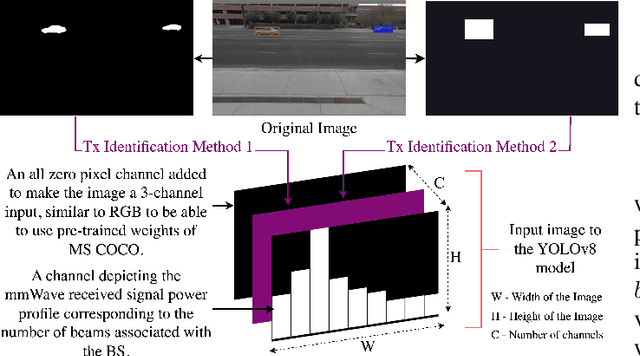

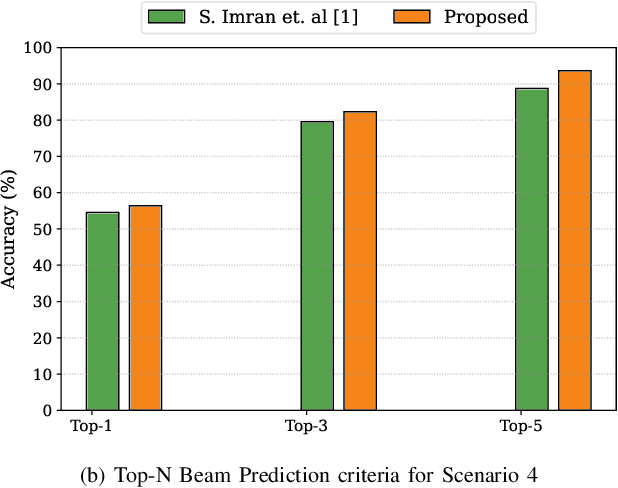
Abstract:Meeting the high data rate demands of modern applications necessitates the utilization of high-frequency spectrum bands, including millimeter-wave and sub-terahertz bands. However, these frequencies require precise alignment of narrow communication beams between transmitters and receivers, typically resulting in significant beam training overhead. This paper introduces a novel end-to-end vision-aided beamforming framework that utilizes images to predict optimal beams while considering geometric adjustments to reduce overhead. Our model demonstrates robust adaptability to dynamic environments without relying on additional training data where the experimental results indicate a top-5 beam prediction accuracy of 98.96%, significantly surpassing current state-of-the-art solutions in vision-aided beamforming.
Rician Channel Modelling for Super Wideband MIMO Communications
Nov 04, 2024Abstract:Recent developments in Multiple-Input-Multiple-Output (MIMO) technology include packing a large number of antenna elements in a compact array to access the bandwidth benefits provided by higher mutual coupling (MC). The resulting super-wideband (SW) systems require a circuit-theoretic framework to handle the MC and channel models which span extremely large bands. Hence, in this paper, we make two key contributions. First, we develop a physically-consistent Rician channel model for use with SW systems. Secondly, we express the circuit-theoretic models in terms of a standard MIMO model, so that insights into the effects of antenna layouts, MC, and bandwidth can be made using standard communication theory. For example, we show the bandwidth widening resulting from the new channel model. In addition, we show that MC distorts line-of-sight paths which has beamforming implications. We also highlight the interaction between spatial correlation and MC and show that tight coupling reduces spatial correlations at low frequencies.
Can FSK Be Optimised for Integrated Sensing and Communications?
May 02, 2024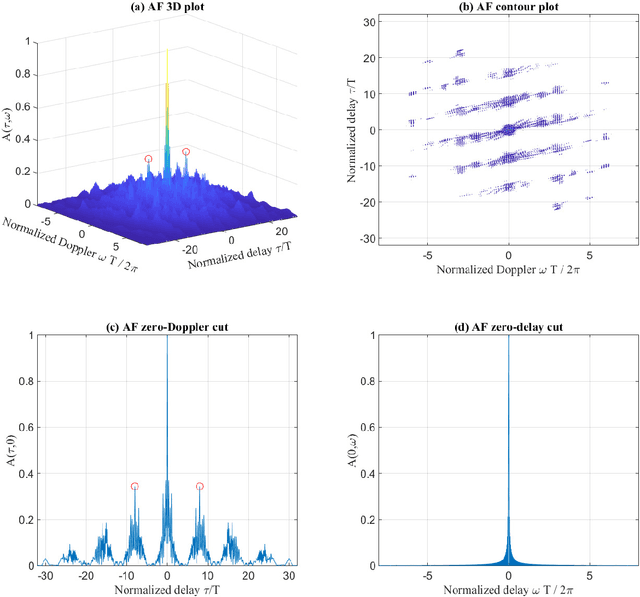
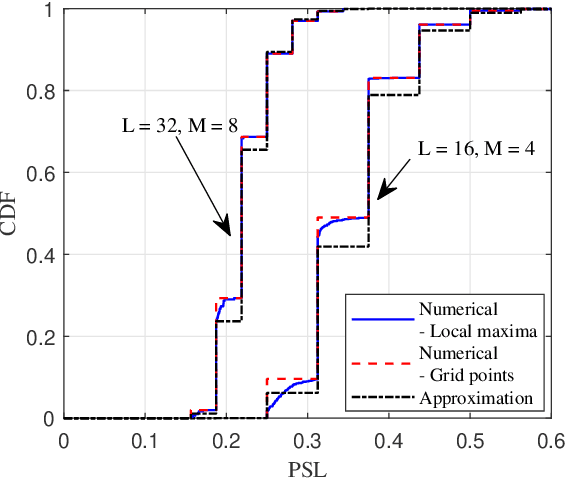
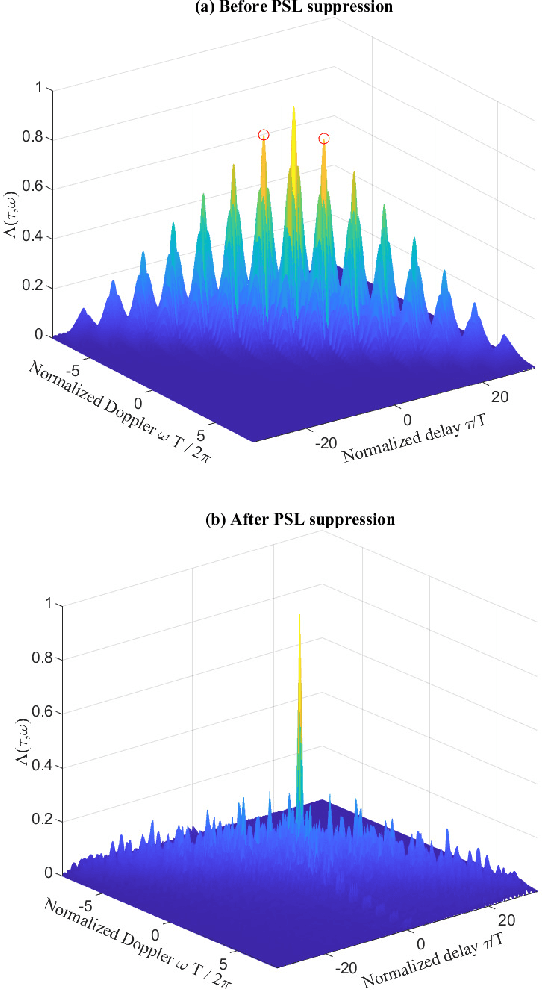
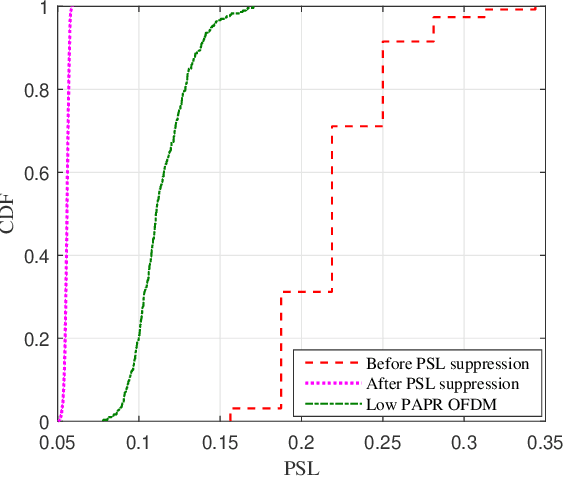
Abstract:Motivated by the ideal peak-to-average-power ratio and radar sensing capability of traditional frequency-coded radar waveforms, this paper considers the frequency shift keying (FSK) based waveform for joint communications and radar (JCR). An analysis of the probability distributions of its ambiguity function (AF) sidelobe levels (SLs) and peak sidelobe level (PSL) is conducted to study the radar sensing capability of random FSK. Numerical results show that the independent frequency modulation introduces uncontrollable AF PSLs. In order to address this problem, the initial phases of waveform sub-pulses are designed by solving a min-max optimisation problem. Numerical results indicate that the optimisation-based phase design can effectively reduce the AF PSL to a level close to well-designed radar waveforms while having no impact on the data rate and the receiver complexity. For large numbers of waveform sub-pulses and modulation orders, the impact on the error probability is also insignificant.
OTFS based Joint Radar and Communication: Signal Analysis using the Ambiguity Function
Oct 07, 2023Abstract:Orthogonal time frequency space (OTFS) modulation has recently been identified as a suitable waveform for joint radar and communication systems. Focusing on the effect of data modulation on the radar sensing performance, we derive the ambiguity function (AF) of the OTFS waveform and characterize the radar global accuracy. We evaluate the behavior of the AF with respect to the distribution of the modulated data and derive an accurate approximation for the mean and variance of the AF, thus, approximating its distribution by a Rice distribution. Finally, we evaluate the global radar performance of the OTFS waveform with the OFDM waveform.
Performance Analysis of Relay Selection Schemes in Multi-Hop Decode-and-Forward Networks
Aug 16, 2023Abstract:This paper analyses the data rate achieved by various relay selection schemes in a single-user multi-hop relay network with decode-and-forward (DF) relaying. While the single-user relay selection problem is well studied in the literature, research on achievable rate maximization is limited to dual-hop networks and multi-hop networks with a single relay per hop. We fill this important gap by focusing on achievable rate maximization in multi-hop, multi-relay networks. First, we consider optimal relay selection and obtain two approximations to the achievable rate. Next, we consider three existing sub-optimal relay selection strategies namely hop-by-hop, ad-hoc and block-by-block relay selection and obtain exact expressions for the achievable rate under each of these strategies. We also extend the sliding window based relay selection to the DF relay network and derive an approximation to the achievable rate. Further, we investigate the impact of window size in sliding window based relay selection and show that a window size of three is sufficient to achieve most of the possible performance gains. Finally, we extend this analysis to a noise limited multi-user network where the number of available relay nodes is large compared to the number of users and derive approximations to the achievable sum-rate.
Frequency Permutation Subsets for Joint Radar and Communication
Jul 21, 2022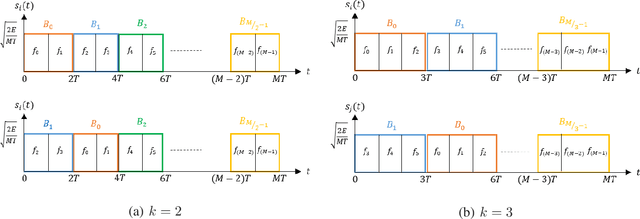
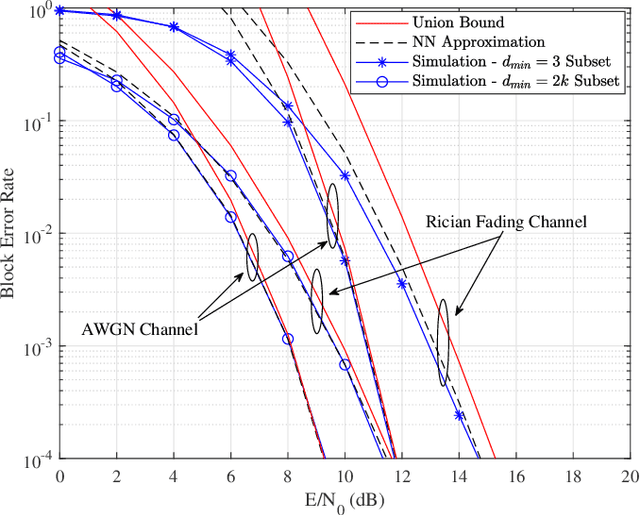
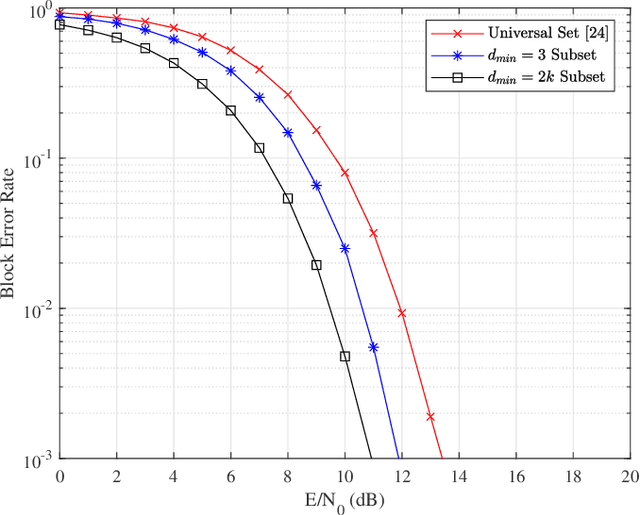
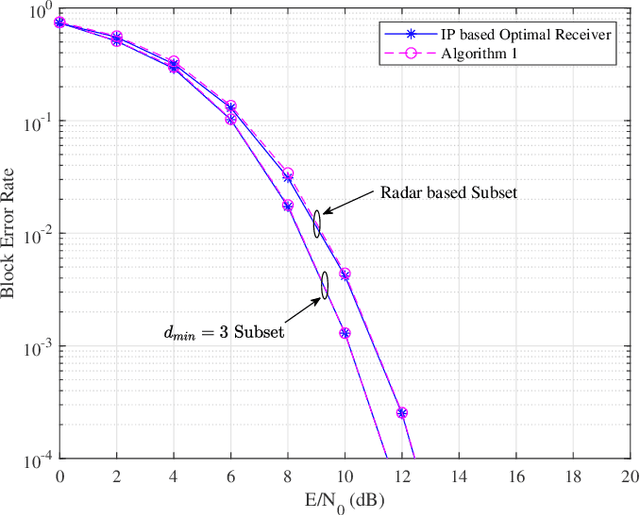
Abstract:This paper focuses on waveform design for joint radar and communication systems and presents a new subset selection process to improve the communication error rate performance and global accuracy of radar sensing of the random stepped frequency permutation waveform. An optimal communication receiver based on integer programming is proposed to handle any subset of permutations followed by a more efficient sub-optimal receiver based on the Hungarian algorithm. Considering optimum maximum likelihood detection, the block error rate is analyzed under both additive white Gaussian noise and correlated Rician fading. We propose two methods to select a permutation subset with an improved block error rate and an efficient encoding scheme to map the information symbols to selected permutations under these subsets. From the radar perspective, the ambiguity function is analyzed with regards to the local and the global accuracy of target detection. Furthermore, a subset selection method to reduce the maximum sidelobe height is proposed by extending the properties of Costas arrays. Finally, the process of remapping the frequency tones to the symbol set used to generate permutations is introduced as a method to improve both the communication and radar performances of the selected permutation subset.
Sum-Rate Optimal Relay Selection and Power Control in Multi-Hop Networks
May 19, 2022



Abstract:In this paper, we focus on the achievable sum-rate optimization problem of a multi-user, multi-hop relay network. We analyze the joint relay selection and power control in the presence of interference such that the achievable sum-rate is maximized. First, we evaluate the achievable sum-rate under five relay selection strategies when the transmit power is fixed. We show that the dynamic programming based max-min relay selection with the objective of maximizing the minimum signal-to-noise-ratio results in the highest achievable sum-rate gain for larger networks. Next, we combine the relay selection problem using the max-min relay selection and the power control problem using a tight lower bound approximation and propose a novel iterative algorithm, which maximizes the achievable sum-rate. We also provide a comprehensive comparison of the proposed algorithm with respect to existing resource allocation techniques, and observe that our proposed algorithm provides significant sum-rate gains. Finally, we prove that for the special case of two-user networks, binary power allocation is optimum for at least two transmitting nodes. Extensive numerical examples are provided to illustrate the accuracy of our results.
Optimal Routing for Multi-user Multi-hop Relay Networks via Dynamic Programming
Mar 01, 2022



Abstract:In this paper, we study the relay selection problem in multi-user, multi-hop relay networks with the objective of minimizing the maximum outage probability across all users. When only one user is present, it is well known that the optimal relay selection problem can be solved efficiently via dynamic programming. This solution breaks down in the multi-user scenario due to dependence between users. We resolve this challenge using a novel relay aggregation approach. On the expanded trellis, dynamic programming can be used to solve the optimal relay selection problem with computational complexity linear in the number of hops. Numerical examples illustrate the efficient use of this algorithm for relay networks.
Combined Radar and Communications with Phase-Modulated Frequency Permutations
Jul 30, 2021
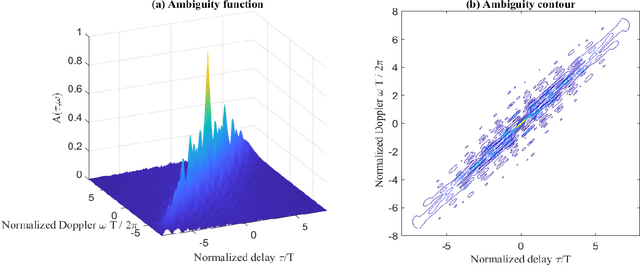

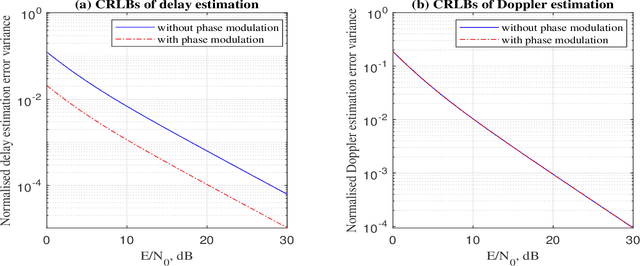
Abstract:This paper focuses on the combined radar and communications problem and conducts a thorough analytical investigation on the effect of phase and frequency change on the communication and sensing functionality. First, we consider the classical stepped frequency radar waveform and modulate data using M-ary phase shift keying (MPSK). Two important analytical tools in radar waveform design, namely the ambiguity function (AF) and the Fisher information matrix (FIM) are derived, based on which, we make the important conclusion that MPSK modulation has a negligible effect on radar local accuracy. Next, we extend the analysis to incorporate frequency permutations and propose a new signalling scheme in which the mapping between incoming data and waveforms is performed based on an efficient combinatorial transform called the Lehmer code. We also provide an efficient communications receiver based on the Hungarian algorithm. From the communications perspective, we consider the optimal maximum likelihood (ML) detector and derive the union bound and nearest neighbour approximation on the block error probability. From the radar sensing perspective, we discuss the broader structure of the waveform based on the AF derivation and quantify the radar local accuracy based on the FIM.
Frequency Permutations for Joint Radar and Communications
May 24, 2021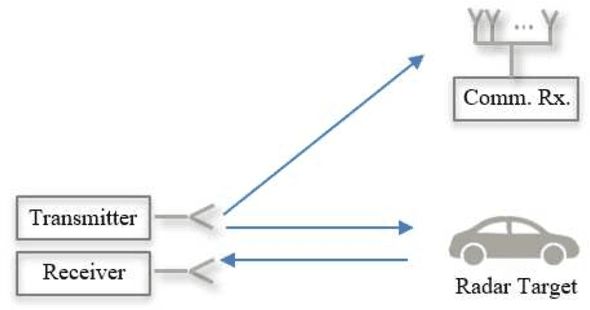

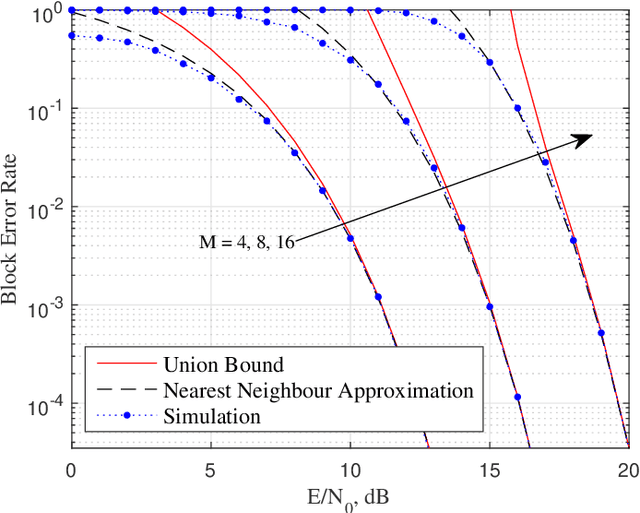
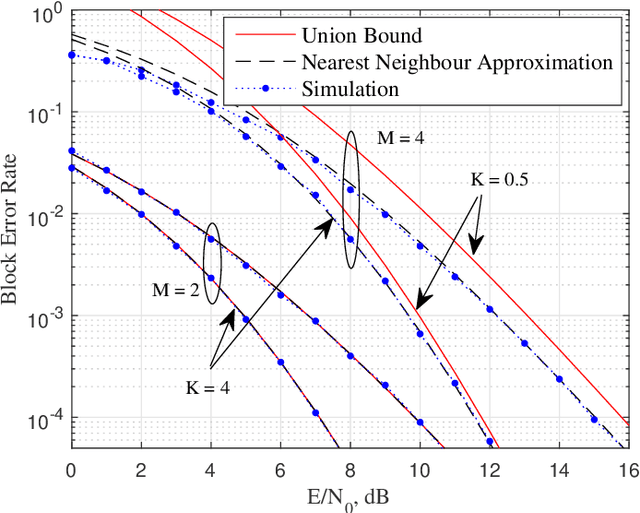
Abstract:This paper presents a new joint radar and communication technique based on the classical stepped frequency radar waveform. The randomization in the waveform, which is achieved by using permutations of the sequence of frequency tones, is utilized for data transmission. A new signaling scheme is proposed in which the mapping between incoming data and waveforms is performed based on an efficient combinatorial transform called the Lehmer code. Considering the optimum maximum likelihood (ML) detection, the union bound and the nearest neighbour approximation on the communication block error probability is derived for communication in an additive white Gaussian noise (AWGN) channel. The results are further extended to incorporate the Rician fading channel model, of which the Rayleigh fading channel model is presented as a special case. Furthermore, an efficient communication receiver implementation is discussed based on the Hungarian algorithm which achieves optimum performance with much less operational complexity when compared to an exhaustive search. From the radar perspective, two key analytical tools, namely, the ambiguity function (AF) and the Fisher information matrix are derived. Furthermore, accurate approximations to the Cramer-Rao lower bounds (CRLBs) on the delay and Doppler estimation errors are derived based on which the range and velocity estimation accuracy of the waveform is analysed. Numerical examples are used to highlight the accuracy of the analysis and to illustrate the performance of the proposed waveform.
 Add to Chrome
Add to Chrome Add to Firefox
Add to Firefox Add to Edge
Add to Edge